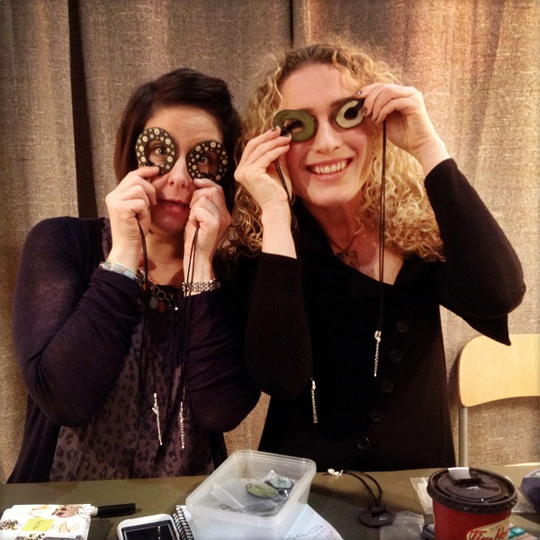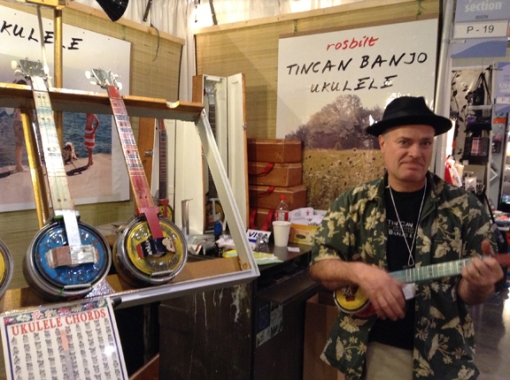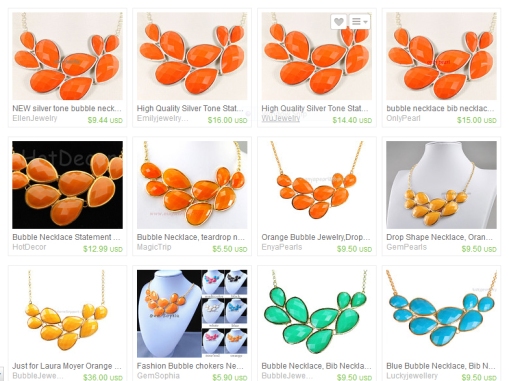
The heading for a Toronto Star article about my mother. I still remember how excited I was to miss school for a whole day to meet with the reporter.
When I was a child, my mother made hand-painted silk scarves for a living. She made them in our house, spreading them out to paint them and then sprinkling them with salt, which shifted as the brightly-coloured dyes dried, creating mesmerizing patterns. She worked late into the night, especially before Christmastime. The production process from start to finish was visible to me and my two sisters, and we often helped out with simple tasks like ironing and packaging. She sold the scarves at craft shows that were full of eager buyers, and I spent a lot of time exploring those shows, meeting other craftspeople and admiring their work.
Now I am older than she was then, I have three children, and I’m a designer/maker too. Sometimes when I’m exhibiting my work at craft shows, as I often do, I meet people who have been doing this since I was a child, and I wonder how they’ve managed to turn handmade production into their life’s work. Is it still possible to support a family in this unusual way today?
I asked Rosemary Thorpe, who with her husband Jerry was at those craft shows of my childhood and is still doing them today, their wooden toy business thriving after more than thirty years. They are living proof that bigger is not always better. They both work on Thorpe Toys full time, making everything in their home-based workshop, using wood cut-offs from local businesses (recycling what would otherwise end up as waste), and have no employees, making only what they can produce themselves. This keeps costs low, so they can keep their toys affordable. The wood is left unfinished, creating a natural look that appeals to environmentalists, do-it-yourselfers, and toxic-toy avoiders (i.e. most parents and grandparents). What a great example of a smart, sustainable handmade business.
But even if a few smart makers have figured out a formula for their own success, what about the field in general? The world is less conducive to this kind of work today than it once was; many of the goods in our homes and on our bodies are cheaper and more disposable than ever. Not long ago it wasn’t uncommon to knit or sew to save money; now the materials alone are often more expensive than buying a manufactured product. The people who make most of our stuff do so under less-than-ideal conditions, but most of the time we don’t mind. Many people throw things away and replace them without a second thought.
Under these conditions, is handmade doomed? Will people willingly seek out and pay more for something when a cheaper option is so readily available? And even if a customer recognizes the value and greater longevity of a handmade product, in this world of fast and disposable do they even care?
This is an important question for professional artisans. Without customers, there would be no handmade industry. Without handmade and locally-made products, we’d be left with only mass-produced stuff, often homogeneous and on a race to the bottom of the price spectrum, even if people and natural resources are abused along the way.
Am I worried? Not at all. In fact, I expect that demand for handmade and locally-made products will grow, not shrink. Am I a chronic optimist? Absolutely. But here’s why I’m so convinced that handmade has a healthy future:
1) Buying something made fairly or locally just feels better. Awareness of the benefits of eating locally-produced food has skyrocketed in recent years. Our understanding about the real costs of industrial far-away farming has grown so much, and so too will our awareness of the real costs of dirt cheap far-away production of goods. The more the media reports about the crises arising from environmental and human neglect by some of the worst factories overseas, the harder it becomes for us to turn our backs on this reality.
2) A desire for unique objects is even stronger in an environment of increasingly mass-produced sameness. Our common desire to wear clothing that expresses who we are and to surround ourselves with special objects that define us (think of the perfect scarf keeping us warm, art on the walls that stirs us, or morning coffee drunk from a special mug) will continue to drive many people to search out handmade work.
3) Do-it-yourself hobbies are thriving. Knitting, quilting, sewing, woodworking — you name it, it’s growing. Not because it’s cheaper than buying things (it’s not), but because it’s so rewarding. Lots of people are spending their leisure time learning traditional skills and enjoying the feeling of creativity and self-sufficiency that brings. Whether it remains a hobby or grows into a business, the impulse to create is strong. Along with that impulse lives a natural appreciation for the creations of talented others.
4) We’re hardwired for social connection. When you know something about the maker of your favourite dress, or mug, or belt, that connection adds an extra dimension to your enjoyment of that object. My handmade maple salad bowl bought from the craftsman who made it (Don Stinson, shown below) cost much more than a wooden bowl from Ikea, but my enjoyment of it over the years has vastly overshadowed that of any mass-produced bowl I have ever owned. We can’t easily surround ourselves with only handmade or locally-made objects, but even a few can enhance our sense of connection every day.

Don Stinson (left) makes incredibly beautiful wooden bowls. His son Jesse works with him. Like the Thorpes, they run a thriving family business centred on handmade production.
Most people love a bargain, and many don’t care how or where things are made. But for those of us who do, I think we’re on the cusp of a burgeoning interest in handmade, with growing numbers of people finding satisfaction in creative enterprise, and growing numbers of customers looking for unique sustainably and ethically-made products.
If you care about handmade, please pass it on!
Happy New Year,
Devorah Miller
Red Thread Design
p.s. You can check out Thorpe Toys at http://www.thorpetoys.com/ and Stinson Studios at http://stinsonstudios.ca/





